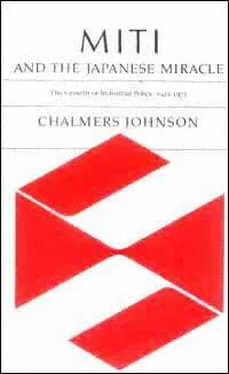Chalmers Johnson - MITI and the Japanese miracle
Здесь есть возможность читать онлайн «Chalmers Johnson - MITI and the Japanese miracle» весь текст электронной книги совершенно бесплатно (целиком полную версию без сокращений). В некоторых случаях можно слушать аудио, скачать через торрент в формате fb2 и присутствует краткое содержание. Год выпуска: 2007, Издательство: Stanford University Press, Жанр: Старинная литература, на английском языке. Описание произведения, (предисловие) а так же отзывы посетителей доступны на портале библиотеки ЛибКат.
- Название:MITI and the Japanese miracle
- Автор:
- Издательство:Stanford University Press
- Жанр:
- Год:2007
- ISBN:нет данных
- Рейтинг книги:3 / 5. Голосов: 1
-
Избранное:Добавить в избранное
- Отзывы:
-
Ваша оценка:
- 60
- 1
- 2
- 3
- 4
- 5
MITI and the Japanese miracle: краткое содержание, описание и аннотация
Предлагаем к чтению аннотацию, описание, краткое содержание или предисловие (зависит от того, что написал сам автор книги «MITI and the Japanese miracle»). Если вы не нашли необходимую информацию о книге — напишите в комментариях, мы постараемся отыскать её.
MITI and the Japanese miracle — читать онлайн бесплатно полную книгу (весь текст) целиком
Ниже представлен текст книги, разбитый по страницам. Система сохранения места последней прочитанной страницы, позволяет с удобством читать онлайн бесплатно книгу «MITI and the Japanese miracle», без необходимости каждый раз заново искать на чём Вы остановились. Поставьте закладку, и сможете в любой момент перейти на страницу, на которой закончили чтение.
Интервал:
Закладка:
Page 203
After only a few years of the Bank of Japan's monetary expansion, the Japanese industrial system took on one of its most distinctive characteristicsthe pattern of dependencies in which a group of enterprises borrows from a bank well beyond the individual companies' capacity to repay, or often beyond their net worth, and the bank in turn overborrows from the Bank of Japan. Since the central bank is the ultimate guarantor of the system, it gains complete and detailed control over the policies and lending decisions of its dependent "private" banks. This so-called indirect financing formula (
kansetsu
kin'yu
*
hoshiki
*) is really only indirect in appearance. As Ito* explains, "Unlike prewar enterprise which was founded on the basis of its own capital, postwar enterprise has been dependent on loans from commercial banks for about 7080 percent of its capital; and in the final analysis these loans are provided on credit from the Bank of Japan, Japan's central bank."
9
The opposite side of this coin, of course, is a relatively slight dependence on equity. "In 1935," writes Broadbridge, "68 percent of industrial funds raised, apart from reserves and depreciation, were derived from sales of stock; in 1963, the figure had fallen to 10 percent.''
10
At least in terms of its financing and ownership structure, Japan was a more capitalist country in the 1930's and 1940's than it was in the 1950's or 1960's.
Ichimada himself appears to have been reluctant to see the system of overloaning expand as far as it did. He regularly declared that the limits of central bank underwriting had been reached, and that a capital crisis was imminent.
11
Also, in order to protect himself and his bank, he became increasingly dependent on guidelines supplied by MITI's Enterprises Bureau on the amounts of capital various industries would need for a given period, and above all on the industries that other branches of the government were protecting and promoting.
12
If the Bank of Japan or the city banks had ever ventured very far from MITI's guidelines and taken on support of an undesignated industry, the risks not just to a particular bank but to the whole system would have become intolerable.
Although it was born of the capital shortage that accompanied the Dodge Line (and is not, as some writers contend, an element of Japanese culture itself), the system of bank overloans was also attractive to Ikeda and his MITI colleagues.
13
It revealed such possibilities of control over and coordination of their highly limited resources that they took steps to continue and institutionalize the system. As Ikeda noted in 1952, dividends on equity shares are paid from corporate profits after taxes, whereas interest on bank loans is deductible for tax purposes. It was thus less expensive for an enterprise to borrow the
Page 204
funds it needed from a bankassuming that it could get them at allthan to try to raise money through issuing new shares.
14
Since the tax system inherited from the occupation was under the control of the Finance Ministry, it was an easy stepalong with many others to be discussed belowto insure that these tax advantages were perpetuated and enlarged. And since the bureaucratic proponents of heavy industrialization saw merits in Ichimada's system, it was continued long after the crisis it was intended to meet had disappeared. A capital market slowly developed in Japan and came to play an increasingly important role in industrial finance, but it did not even begin to rival bank lending as a source of capital until the 1970's.
One advantage of the overloaning system was that managers were not pressured by stockholders, which meant that they could ignore short-term profitability as a measure of their own performance and could concentrate instead on such things as foreign market penetration, quality control, and long-term product development. This became a considerable advantage when Japanese managers began to compete seriously with American firms, since short-term profitability and the payment of dividends were the keys to the availability of capital for American enterprises (not to mention also being the keys to an American manager's longevity in his job). Another advantage was the ease and precision with which the government could employ monetary controls alone to expand or contract the tempo of economic activity in response to international balance of payments constraints. A less desirable feature of the dependence on borrowing was that it left Japanese companies with so little paid-in capital that they were easy targets for foreign purchase. However, this state of affairs only increased civilian demands for the protection of the Japanese economy, which the bureaucrats wanted to pursue anyway on nationalistic grounds. The resultant community of interests reinforced both sides.
Of all the consequences of Ichimada's system, certainly the most important was the fostering of bank keiretsu (conglomerate groups) as successors to the zaibatsu, since without them the Japanese economy might not have enjoyed the high degrees of competition that prevailed in its otherwise government-dominated big business sector. By the 1960's, as we shall see in the next chapter, many MITI officials had begun to doubt the value of this featurebut it must be said that MITI bureaucrats, none of whom had ever experienced an open economic system until the 1960's, have consistently undervalued the role of competition in the structure they created.
Since the time of the stabilization panic, which had made enterprises dependent on banks for their capital, each enterprise had tried
Page 205
to develop a close working relationship with a particular bank; it did not necessarily get all the money it needed or preferential terms from its primary bank, but it did get the one thing it could not do withoutaccess to capital in the first place because it was an established customer. The banks in turn became dependent upon the financial health of their heavily indebted priority industries and therefore took responsibility for them. The resulting cooperative arrangements looked very much like the old German banking groups, such as those of the Deutsche or Dresdner banks, with cross-shareholding between banks and affiliated industries (such shareholding is illegal in the United States).
*
The difference from the German pattern was that the Japanese government exercised much greater control over the "financial lineages" (
kin'yu
*
keiretsu
), as they came to be called, than the German government ever did over its bank groups and syndicates. The "big six" among the Japanese conglomerates that came into being during the 1950's were those based on the Fuji, Sanwa, Dai Ichi, Mitsui, Mitsubishi, and Sumitomo banks. The Fuji Bank, for example, established financial ties with the old Yasuda zaibatsu, the old Asano zaibatsu (which contributed the Fuji group's steel company, Nippon Kokan*), and Ayukawa Gisuke's old Nissan companiesand after 1955 with its own trading company, Marubeni-Iida, formed by the merger of Marubeni and Takashimaya-Iida.
A typical Japanese group includes a big bank, several industrial firms, and a general trading company. The bank plays the critical role during expanding business conditions by supplying capital to the members, and the trading company plays the critical role during contracting business conditions by importing raw materials on credit and fiercely promoting exports of products that cannot be sold domestically. SCAP broke up the old zaibatsu trading companies, but as soon as the occupation was over, MITI busily rebuilt them. Mitsui Bussan and Mitsubishi Shoji* were dissolved on November 30, 1947, and their liquidation completed on August 31, 1950. The largest and most successful Mitsui offshoots were the Dai Ichi, Sanshin, and Kyo-kuto* trading companies, while the leading Mitsubishi splinters were the Tozai*, Fuji, and Toyo* trading companies. By the end of 1952, the successor Mitsubishi companies had already recombined, but Mitsui took until the end of 1955 to come back together.
Читать дальшеИнтервал:
Закладка:
Похожие книги на «MITI and the Japanese miracle»
Представляем Вашему вниманию похожие книги на «MITI and the Japanese miracle» списком для выбора. Мы отобрали схожую по названию и смыслу литературу в надежде предоставить читателям больше вариантов отыскать новые, интересные, ещё непрочитанные произведения.
Обсуждение, отзывы о книге «MITI and the Japanese miracle» и просто собственные мнения читателей. Оставьте ваши комментарии, напишите, что Вы думаете о произведении, его смысле или главных героях. Укажите что конкретно понравилось, а что нет, и почему Вы так считаете.












